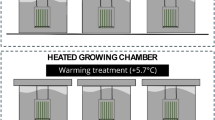Abstract
Tradescantia fluminensis is an invasive plant species in New Zealand, Australia and parts of the USA. It reproduces vegetatively and can grow to form dense mats up to 60 cm deep. Growth is limited by available light, and shading is one of the few effective methods of control. In this paper, we develop a dynamic model of a vertical cross section of a T. fluminensis mat, capturing vertical variation in its biomass and internal light intensity. We measure both variables at different heights in experimental mats of the species and use these data to parameterize the model. The model produces realistic vertical biomass and light intensity profiles. We show that the mat grows to a steady-state biomass that depends only on: (i) the light absorption coefficient, which we estimate from experimental data and (ii) the ratio of photosynthesis to respiration rate. This steady state undergoes a transcritical bifurcation; when the ambient light intensity falls below a critical level, the biomass shrinks to zero and the mat cannot survive.





Similar content being viewed by others
References
Adams TP, Holland EP, Law R, Plank MJ, Raghib M (2013) On the growth of locally interacting plants: differential equations for the dynamics of spatial moments. Ecology 94(12):2732–2743
Brunner A (1998) A light model for spatially explicit forest stand models. For Ecol Manag 107:19–46
Burns JH (2008) Demographic performance predicts invasiveness of species in the Commelinaceae under high-nutrient conditions. Ecol Appl 18(2):335–346
Butcher ER, Kelly D (2011) Physical and anthropogenic factors predict distribution of the invasive weed Tradescantia fluminensis. Austral Ecol 36(6):621–627
Cannell MGR, Thornley JHM (2000) Modelling the components of plant respiration: some guiding principles. Ann Bot 85:45–54
Fowler SV, Barreto R, Dodd S, Macedo DM, Paynter Q, Pedrosa-Macedo JH, Pereira OL, Peterson P, Smith L, Winks CJ, Waipara N (2013) Tradescantia fluminensis, an exotic weed affecting native forest regeneration in New Zealand: ecological surveys, safety tests and releases of four biocontrol agents from Brazil. Biol Control 64(3):323–329
Hogan AB, Myerscough MR (2017) A model for the spread of an invasive weed, Tradescantia fluminensis. Bull Math Biol 79(6):1201–1217
Jaeger M, De Reffye P (1992) Basic concepts of computer simulation of plant growth. J Biosci 17(3):275–291
James A, Molloy SM, Ponder-Sutton A, Plank MJ, Lamoureaux SL, Bourdôt GW, Kelly D (2015) Modelling Tradescantia fluminensis to assess long term survival. Peer J 3:e1013
Kelly D, Skipworth J (1984a) Tradescantia fluminensis in a Manawatu (New Zealand) forest: I. Growth and effects on regeneration. N Z J Bot 22(3):393–397
Kelly D, Skipworth J (1984b) Tradescantia fluminensis in a Manawatu (New Zealand) forest: II. Management by herbicides. N Z J Bot 22(3):399–402
Maule H, Andrews M, Morton J, Jones A, Daly G (1995) Sun/shade acclimation and nitrogen nutrition of Tradescantia fluminensis, a problem weed in New Zealand native forest remnants. N Z J Ecol 19(1):35–46
McAlpine KG, Lamoureaux SL, Westbrooke I (2015) Ecological impacts of ground cover weeds in New Zealand lowland forests. N Z J Ecol 39(1):50–60
McAlpine KG, Lamoureaux SL, Timmins SM, Wotton DM (2017) Native woody plant recruitment in lowland forests invaded by non-native ground cover weeds and mammals. N Z J Ecol 41(1):65–73
McAlpine KG, Lamoureaux SL, Timmins SM, Wotton DM (2018) Can a reduced rate of herbicide benefit native plants and control ground cover weeds? N Z J Ecol 42(2):204–213
Perry LG, Neuhauser C, Galatowitsch SM (2003) Founder control and coexistence in a simple model of asymmetric competition for light. J Theor Biol 222(4):425–436
Prusinkiewicz P (2004) Modeling plant growth and development. Curr Opin Plant Biol 7(1):79–83
Scott LI, Priestley J (1925) Leaf and stem anatomy of Tradescantia fluminensis, Vell. J Linn Soc Lond Bot 47(312):1–28
Sellier D, Plank MJ, Harrington JJ (2011) A mathematical framework for modelling cambial surface evolution using a level set method. Ann Bot 108(6):1001–1011
Standish RJ (2002) Experimenting with methods to control Tradescantia fluminensis, an invasive weed of native forest remnants in New Zealand. N Z J Ecol 26(2):161–170
Standish RJ (2004) Impact of an invasive clonal herb on epigaeic invertebrates in forest remnants in New Zealand. Biol Conserv 116(1):49–58
Toft RJ, Harris RJ, Williams PA (2001) Impacts of the weed Tradescantia fluminensis on insect communities in fragmented forests in New Zealand. Biol Conserv 102(1):31–46
Vance RR, Nevai AL (2007) Plant population growth and competition in a light gradient: a mathematical model of canopy partitioning. J Theor Biol 245(2):210–219
Yan HP, Kang MZ, De Reffye P, Dingkuhn M (2004) A dynamic, architectural plant model simulating resource-dependent growth. Ann Bot 93(5):591–602
Yeates GW, Williams PA (2001) Influence of three invasive weeds and site factors on soil microfauna in New Zealand. Pedobiologia 45(4):367–383
Acknowledgements
We thank Dave Conder and Ben Jeffries for assistance with experimental set-up, equipment and data collection, and Dave Kelly for insight into the plant’s ecology. This Project was partly funded by the Foundation for Research, Science and Technology (now Ministry of Business, Innovation and Employment) and Manaaki Whenua Landcare Research Core Funding under the programme Beating Weeds II (C09X0905).
Author information
Authors and Affiliations
Corresponding author
Additional information
Publisher's Note
Springer Nature remains neutral with regard to jurisdictional claims in published maps and institutional affiliations.
Electronic Supplementary Material
Below is the link to the electronic supplementary material.
Rights and permissions
About this article
Cite this article
Plank, M.J., Stringer, N., Lamoureaux, S.L. et al. Limiting Effect of Self-Shading on the Height of Tradescantia fluminensis Mats. Bull Math Biol 81, 3918–3932 (2019). https://doi.org/10.1007/s11538-019-00631-y
Received:
Accepted:
Published:
Issue Date:
DOI: https://doi.org/10.1007/s11538-019-00631-y




